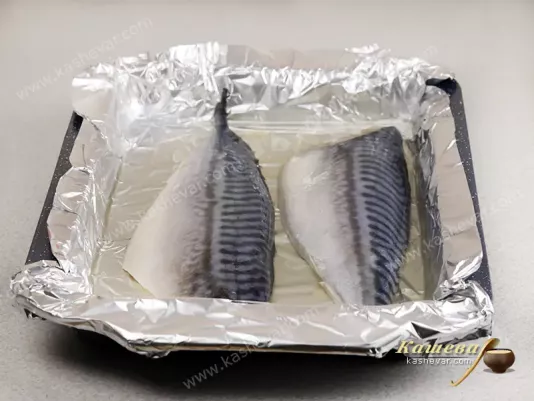Kimbap with Mackerel
Kimbap with mackerel is a Korean recipe, very simple and satisfying with simple ingredients.

Marinated mackerel is an ingredient I treat with special care. Over the years at the stove, I’ve learned to recognize its freshness by touch and smell: when the flesh is firm, elastic, and free of sourness – that’s a sign of quality fish. I observe how the fillet reacts to the knife – fresh mackerel slices smoothly without tearing. The marinade’s aroma evolves over time: initially sharp, later soft and harmonious as the spices blend together. Properly prepared mackerel has light gray flesh, a delicate aroma, and a clean aftertaste with no bitterness. I like to add rings of red onion, allspice, and bay leaf – these details create harmony. In salads, it becomes the accent; in appetizers, the foundation. And each time I serve it, I taste not just the fish, but the result of patience and experience developed over the years.
Over the years of cooking, I’ve learned to see the difference between fish that’s merely salted and fish that’s truly marinated with understanding. I always start with appearance: fresh mackerel has an evenly light-gray color without yellowish tones, clean shiny skin, and firm texture. If I notice a cloudy marinade or sediment at the bottom of the jar, I don’t take the risk – it signals an old product. Good mackerel holds its shape, doesn’t fall apart, and has no slime. Its scent is light, with a gentle spice aroma and the purity of the sea. When buying by weight, I ask to cut a piece: the flesh should be dense, not spongy. A strong vinegar smell is a bad sign – that kind of marinade masks freshness. And genuine mackerel shouldn’t shine unnaturally: if the color is too bright or perfectly even, the producer likely used dyes. Once I find a trusted supplier, I stay with them for years. Quality is everything here – no recipe can save poor fish.
Before adding mackerel to a dish, I always prepare it for combination. If the fish is too salty, I soak it in cold water for a few minutes – just enough to restore balance. Then I dry the fillet with paper towels: even a drop of water can ruin the texture or alter the flavor of a salad. Over the years, I’ve noticed that it’s best to slice mackerel when it has warmed slightly to room temperature – the flesh stays elastic, doesn’t crumble, and the aroma fully unfolds. For salads, I remove the skin for a softer texture; for appetizers, I keep some of it – it adds shine and visual appeal. I always slice diagonally with a sharp knife, thinly, to preserve the fibers. Marinated mackerel’s texture is delicate, and any careless move turns it to mush. If I need to use it in a warm dish, I gently heat the pieces over low heat for just a few seconds – enough to awaken the spices without losing juiciness.
Marinated mackerel doesn’t need long cooking, but in skillful hands, it becomes the base of complex flavor compositions. Sometimes I use gentle warming when making tartines or warm salads. It’s important not to overheat the fish, or it will lose both texture and aroma. For light appetizers, I pair mackerel with roasted vegetables or potatoes – their mild sweetness enhances the marinade’s tangy note. The leftover marinade can be used sparingly for dressings – just a few drops mixed with oil and mustard add depth. When serving on bread, I choose rye or grain bread, slightly toasted to emphasize texture. In hot dishes, such as pasta or casseroles, I add mackerel at the end so it only warms through. On medium heat, 20-30 seconds are enough to revive the spice aroma. My students often ask why such precision matters. I answer – mackerel doesn’t tolerate haste but won’t forgive excess either.
Mackerel loves balance. Its natural fattiness and mild acidity call for companions that either soften or highlight its flavor. I often pair it with beetroot, apple, or citrus – these ingredients add freshness. Boiled potatoes, pumpkin, or hard-boiled egg are classic partners that create textural harmony. In salads, I add a bit of oil to smooth out acidity, and in sandwiches – a slice of butter or cream cheese for tenderness. For a festive touch, I serve mackerel with capers, green onions, and dill – the spice aroma livens up the fish, making it refined. For modern presentations, I combine it with roasted beetroot and orange zest – that contrast is magical. The key is not to overload: no excessive spices or mayonnaise. Everything should sound pure. I always say: marinated mackerel isn’t just an ingredient – it’s the voice of the sea on your plate, and it doesn’t tolerate noise around it.
I’ve seen many cooks ruin mackerel trying to “improve” its flavor. The most common mistake is remarinating or adding too much vinegar. This makes the fish lose its tenderness and become harsh. I always stress: trust the product’s natural flavor, don’t try to overpower it. Another mistake is improper storage. An open jar in the fridge is a direct path to spoilage. I transfer the mackerel to a glass container, cover it with a thin layer of oil, and keep it at +2-6°C (36-43°F). It stays fresh for up to ten days. Before serving, I check the smell and color: if the fish has darkened or looks unnaturally bright, it’s better not to use it. Also, always watch for bones – small remnants can ruin the experience. And never cut mackerel with a dull knife, as it pulls and tears the flesh. A good knife and a steady hand are the keys to beautiful presentation. I always tell my students: the quality of mackerel is not only about the product itself but also about how you treat it.